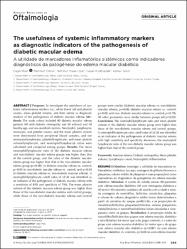| dc.contributor.author | İlhan, Çağrı | |
| dc.contributor.author | Çıtırık, Mehmet | |
| dc.contributor.author | Uzel, Mehmet Murat | |
| dc.contributor.author | Kızıltoprak, Hasan | |
| dc.contributor.author | Tekin, Kemal | |
| dc.date.accessioned | 2021-03-18T11:00:47Z | |
| dc.date.available | 2021-03-18T11:00:47Z | |
| dc.date.issued | 2020 | en_US |
| dc.identifier.issn | 0004-2749 | |
| dc.identifier.issn | 1678-2925 | |
| dc.identifier.uri | https://doi.org/10.5935/0004-2749.20200051 | |
| dc.identifier.uri | https://hdl.handle.net/20.500.12462/11236 | |
| dc.description | Uzel, Mehmet Murat (Balikesir Author) | en_US |
| dc.description.abstract | Purpose: To investigate the usefulness of systemic inflammatory markers [i.e., white blood cell and platelet counts, mean platelet volume, and their ratios] as diagnostic markers of the pathogenesis of diabetic macular edema. Methods: The study cohort included 80 diabetic macular edema patients (40 with diabetic retinopathy and 40 without) and 40 healthy age- and sex-matched controls. Neutrophil, lymphocyte, monocyte, and platelet counts, and the mean platelet volume were determined from peripheral blood samples, and the monocyte/lymphocyte, platelet/lymphocyte, and mean platelet volume/lymphocyte, and neutrophil/lymphocyte ratios were calculated and compared among groups. Results: The mean neutrophil/lymphocyte ratio of the diabetic macular edema and non-diabetic macular edema groups was higher than that of the control group, and the value of the diabetic macular edema group was higher than that of the non-diabetic macular edema group (p<0.001 in diabetic macular edema vs. control, p=0.04 in non-diabetic macular edema vs. control, and p=0.03 in diabetic macular edema vs. non-diabetic macular edema). A neutrophil/lymphocyte cutoff value of >= 2.26 was identified as an indicator of the pathogenesis of diabetic macular edema with a sensitivity of 85% and specificity of 74%. The mean platelet volume of the diabetic macular edema group was higher than those of the non-diabetic macular edema and control groups, while those of the non-diabetic macular edema and control groups were similar (diabetic macular edema vs. non-diabetic macular edema, p=0.08; diabetic macular edema vs. control, p=0.02; and non-diabetic macular edema vs. control, p=0.78). All other parameters were similar between groups (all p>0.05). Conclusion: The neutrophil/lymphocyte ratio and mean platelet volume of the diabetic macular edema group were higher than those of the non-diabetic macular edema and control groups. A neutrophil/lymphocyte ratio cutoff value of >= 2.26 was identified as an indicator of the pathogenesis of diabetic macular edema with high sensitivity and specificity. Moreover, the neutrophil/ lymphocyte ratio of the non-diabetic macular edema group was higher than that of the control group. | en_US |
| dc.language.iso | eng | en_US |
| dc.publisher | Consel Brasil Oftalmologia | en_US |
| dc.relation.isversionof | 10.5935/0004-2749.20200051 | en_US |
| dc.rights | info:eu-repo/semantics/openAccess | en_US |
| dc.rights | Attribution 3.0 United States | * |
| dc.rights.uri | http://creativecommons.org/licenses/by/3.0/us/ | * |
| dc.subject | Macular Edema | en_US |
| dc.subject | Diabetic Retinopathy | en_US |
| dc.subject | Mean Platelet Volume | en_US |
| dc.subject | Lymphocyte Count | en_US |
| dc.subject | Neutrophils | en_US |
| dc.subject | Inflammation | en_US |
| dc.title | The usefulness of systemic inflammatory markers as diagnostic indicators of the pathogenesis of diabetic macular edema | en_US |
| dc.type | article | en_US |
| dc.relation.journal | Arquivos Brasileiros de Oftalmologia | en_US |
| dc.contributor.department | Tıp Fakültesi | en_US |
| dc.contributor.authorID | 0000-0002-7420-8934 | en_US |
| dc.identifier.volume | 83 | en_US |
| dc.identifier.issue | 4 | en_US |
| dc.identifier.startpage | 299 | en_US |
| dc.identifier.endpage | 304 | en_US |
| dc.relation.publicationcategory | Makale - Uluslararası Hakemli Dergi - Kurum Öğretim Elemanı | en_US |




















